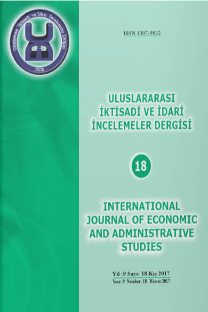EKONOMETRİ ÖĞRENCİLERİNİN SAYISAL DERSLERDEKİ AKADEMİK PERFORMANSI: MARKOV MODELİ İLE BİR HESAPLAMA
Ekonometri, Yüksek öğrenim, Markov modeli, ki kare testi
ACADEMIC PERFORMANCE OF ECONOMETRICS STUDENTS IN QUANTITATIVE COURSES: A PREDICTION USING MARKOV MODEL
Econometrics, Higher education, Markov model, Chi Square tests,
___
- Baasch, A., Tischew, S. ve Bruelheide, H. (2010). Twelve years of succession on sandy substrates in a post-mining landscape: A Markov chain analysis, Ecological Applications, 20(4), 1136-1147.
- Cavers, M.S. ve Vasudevan, K. (2015). Brief Communication: Earthquake sequencing: Analysis of Time Series constructed from the Markov Chain Model, Nonlinear Process Geophysics, 22, 589-599.
- Farg, M. H. M. ve Khalil, F. M. H. (2015). Statistical Analysis of Academic Level of Student in Quantitative Methods Courses By Using Chi-Square Test and Markov Chains - Case Study of Faculty of Sciences and Humanities (Thadiq). Nat Sci,12(12), 182- 186.
- Grimshaw, S.D. ve Alexander, W.P. (2011). Markov Chain Models for Deliquency: Transition Matrix Estimation and Forecasting, John Wiley&Sons, Applied Stochastic Models in Business and Industry, 27, 267-279.
- Industrial Engineering Operations Research. (2008). Derman, E., Park, K.S. ve Whitt, W. http://ieor.columbia.edu/files/seasdepts/industrial-engineering-operations-research/pdf-files/Park_Informs.pdf
- Lazri, M., Ameur, S., Brucker, J.M., Lahdir, M. ve Sehad, M. (2015). Analysis of drought areas in northern Algeria using Markov chains, J. Earth Syst. Sci., 124(1), 61–70.
- Lukić, P.,Gocić, M. ve Trajković, S. (2013). Prediction of annual precipitation on the territory of south Serbia using Markov chains, Bulletin of the Faculty of Forestry, 108, 81-92.
- Mavruk, C. ve Kıral, E. (2016). Academic progress of students in quantitative courses at Nigde University Vocatıonal School of Social Sciences: A predictıon using Markov model, Niğde Üniversitesi İktisadi ve İdari Bilimler Fakültesi Dergisi, 9(3), 267-276.
- Mieruch, S., Noel, S., Bovensmann, H., Burrows, J. P. ve Freund, J. A. (2010). Markov chain analysis of regional climates. Nonlinear Processes in Goephysics, 17, 651–661.
- Ng, W. S. (2013). Persistence of Mutual Fund Ratings: A Markov Chain Approach. Indian Finance Conference: Econometrics February 2013, Singapore Management University, Singapore. http://ink.library.smu.edu.sg/etd_coll/99
- Pehkonen, J. ve Tervo, H. (1998). Persistence and turnover ın regional unemployment disparities, Regional Studies, 32(5), 445-458.
- Serfozo, R. (2009). Basics of Applied Stochastic Processes,(1st Edition). Berlin Heidelberg: Springer-Verlag.
- Usher, M.B. (1979). Markovian Approaches to Ecological Succession, Journal of Animal Ecology, 48(2), 413-426.
- Yeh, H.W., Chan, W., Symanski, E. ve Davis, B.R. (2010). Estimating Transition Probabilities for Ignorable Intermittent Missing Data in a Discrete-Time Markov Chain, Communications in Statistics- Simulation and Computation, 39(2), 433-448.
- ISSN: 1307-9832
- Yayın Aralığı: 4
- Başlangıç: 2008
- Yayıncı: Kenan ÇELİK
ÇOK KRİTERLİ KARAR VERME METODU ÇERÇEVESİNDE ELEKTRİK ARIZA ANALİZİNİN DEĞERLENDİRİLMESİ
Ümmü Gülsüm ERASLAN, Figen BALO, Büşra ÇETİN, Ukbe Üsame UÇAR
BAŞLIK YENİ ÜRÜNÜN BASS DİFÜZYON MODELİ İLE SATIŞ ÖNRAPORLAMASI
Mustafa SEVÜKTEKİN, Tuğba YILMAZ, Melih KARA
TERCİH VERİLERİNİN İDEAL NOKTA VE VEKTÖR MODELLERİ İLE ANALİZİ
FİRMA FİNANSAL BAŞARISIZLIK ÖNGÖRÜSÜ İÇİN BİR LOJİSTİK REGRESYON MODELİ
Tuba YAKICI AYAN, Nurdan DEĞİRMENCİ
İrem EFE, Esin FİRUZAN, Berhan ÇOBAN
TÜRKİYE ÇIKTI AÇIĞININ FİLTRELEME VE AYRIŞTIRMA YÖNTEMLERİYLE TAHMİNİ
Eda YALÇIN KAYACAN, Şenay ÜÇDORUK BİRECİKLİ
HAVA KİRLİLİĞİ İLE EKONOMİK BÜYÜME ARASINDAKİ İLİŞKİNİN EKONOMETRİK ANALİZİ
KAÇAKÇILIKTA YAKALANAN MALZEME TÜRLERİNE GÖRE SUÇLULARIN KÜMELENMESİ: İKİLİ KÜMELEME YÖNTEMİ
Ramazan ARSLAN, H. Hasan ÖRKCÜ, Bülent ALTUNKAYNAK
ULUSLARARASI ÖĞRENCİLERİN SOSYAL UYUM PROBLEMİNİ BELİRLEMEDE LOGLİNEER MODEL KULLANIMI
Mehmet AKSARAYLI, Osman PALA, Dilayla BAYYURT, Mehmet Akif AKSOY, Ayşegül CENGER
